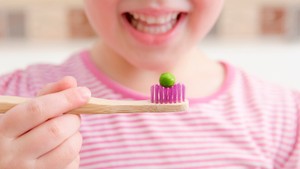Blog
Understanding when to introduce fluoride toothpaste to children is a significant step in this process
Maintaining your child’s dental health is a vital part of their overall well-being, and understanding when to introduce fluoride toothpaste to children is a significant step in this process. Fluoride, a naturally occurring mineral, strengthens tooth enamel and protects against decay. However, introducing fluoride too early or using it incorrectly can be concerning for parents. This guide offers essential insights on when to start using fluoride toothpaste, selecting the right product, and ensuring safe usage. By instilling healthy oral hygiene habits early on, you can pave the way for your child to enjoy lifelong bright smiles and robust dental health.
Why Fluoride Is Essential for Dental Health
Fluoride is integral in cavity prevention, making it a cornerstone of children’s dental care. This mineral not only strengthens tooth enamel but also inhibits the growth of bacteria that cause decay. Incorporating fluoride into your child’s dental routine significantly reduces their risk of cavities, promoting a healthier smile.
Fluoride fortifies enamel, the outer protective layer of teeth, making it resistant to acids from plaque and sugary foods. This protective effect helps repair early decay signs and guards against future damage. Regular use of fluoride toothpaste, paired with professional dental care, establishes optimal oral hygiene habits early, enhancing immediate dental health and setting the stage for a lifetime of strong smiles. Understanding fluoride’s benefits enables parents to make informed decisions about when to introduce fluoride toothpaste to children, ensuring their children reap the full benefits of this vital mineral.
When Should You Start Using Fluoride Toothpaste?
The American Dental Association (ADA) recommends considering when to start using fluoride toothpaste when a child is around two years old. At this stage, children generally have enough teeth to benefit from fluoride’s enamel-strengthening and cavity-preventing properties. Observing your child’s readiness, such as the ability to spit out toothpaste, typically developing around age two or three, is crucial. If your child tends to swallow toothpaste, consider using a smear of fluoride-free toothpaste until they can spit effectively.
Following expert guidelines is essential. The ADA advises using a pea-sized amount of fluoride toothpaste for children aged three and older. For those under three, a smear of fluoride toothpaste is recommended. Regular pediatric dental visits can provide tailored advice on best practices for your child’s dental health.
Choosing the Right Fluoride Toothpaste
Selecting the appropriate fluoride toothpaste involves understanding how much fluoride is in toothpaste for children’s dental care. Children’s toothpaste contains lower fluoride concentrations, suitable for younger children who might swallow some paste. Adult toothpaste has higher fluoride levels, effective for older individuals who can spit out toothpaste without swallowing.
Fluoride concentrations in toothpaste vary. The ADA suggests that toothpaste for children aged 2 to 6 years should have 1,000 parts per million (ppm) of fluoride. For those under 2 years old, a fluoride concentration of 500 ppm or less is advisable. This ensures fluoride is beneficial without risking dental fluorosis, a condition from excessive early childhood fluoride exposure.
Consider your child’s age and dental needs when choosing toothpaste. For toddlers, a smear of fluoride toothpaste suffices, while children aged 3 to 6 can use a pea-sized amount. Supervise brushing to ensure they use the correct amount and avoid excessive swallowing.
How to Safely Use Fluoride Toothpaste with Young Children
Introducing fluoride toothpaste into your child’s dental routine is crucial, but safety is paramount. For children under three, use a smear or rice-sized amount of fluoride toothpaste. At three, increase to a pea-sized amount, balancing fluoride benefits with minimal swallowing risk.
Effective brushing techniques are key. Position your child comfortably, use a soft-bristled toothbrush, and guide the brush at a 45-degree angle to their gums. Brush gently in circular motions, covering all tooth surfaces. Make brushing fun by singing or counting to encourage thorough brushing for at least two minutes.
Supervise brushing until your child is around seven or eight years old to ensure effective brushing and appropriate toothpaste use. Encourage them to spit out toothpaste after brushing and avoid immediate rinsing, allowing fluoride to remain on teeth longer. Your guidance fosters a lifelong habit of good oral hygiene.
Addressing Common Concerns about Fluoride
Introducing fluoride toothpaste to children raises safety concerns, especially for those under two. The ADA recommends starting fluoride toothpaste use when the first tooth appears, around six months old. For children under two, a smear or rice-sized amount of fluoride toothpaste is safe and effective, strengthening enamel without risk of excessive ingestion.
Despite myths about fluoride, research consistently supports its safety and cavity-preventing efficacy. Dental fluorosis, caused by excessive early fluoride exposure, is avoidable with proper toothpaste use. Fluoride, used correctly, is crucial for strong teeth and decay prevention.
For concerned parents, fluoride-free natural toothpaste alternatives can maintain oral hygiene but consult your pediatric dentist to ensure adequate cavity protection.
Establishing Healthy Oral Hygiene Habits Early
Beginning dental care early is vital for your child’s overall health. The American Academy of Pediatric Dentistry advises cleaning your child’s mouth before teeth erupt with a soft, damp cloth. This early start not only prevents cavities but also sets the foundation for lifelong healthy habits.
Making brushing enjoyable encourages children to embrace their oral hygiene routine. Use colorful toothbrushes and fluoride toothpaste with fun flavors appealing to young tastes. Turn brushing into a game by playing songs or using timers. Creating positive associations with brushing fosters lifelong dental health commitment.
Schedule your child’s first dental visit by their first birthday or when their first tooth appears. This visit familiarizes them with the dentist and ensures proper tooth development. Early visits offer guidance on brushing techniques and when to introduce fluoride toothpaste to children, ensuring your child starts their journey to a healthy smile on the right foot.





